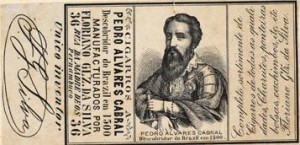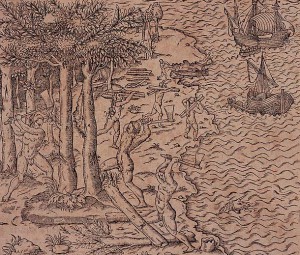
Wikimedia Commons
Pedro Alvares Cabral
The first natural resources found by explorers and colonists that had potential for profit was a red wood that was used to

Wikimedia Commons
Finding Pau-Brasil
make a dye called pau-brasil. This commodity eventually gave the colony its name. Most early settlers actually made their livings through a combination of trade and farming, but in the 16th century, colonists began to grow sugarcane. Sugar was greatly sought after in Europe, which meant that Portuguese colonists could sell their product and make large profits. At first, they tried to create a work force by enslaving the native peoples of Brazil using bandeirantes. These men captured native peoples to work on plantations and also tracked down fleeing slaves. Soon, however, it became clear that native Brazilians could not meet the harsh expectations of the Portuguese, in large part because their mortality rate had soared due to western diseases. Consequently, the Portuguese began transporting Africans to South America to work the sugarcane.
These enslaved Africans were transported in such large numbers that, by the late 18th century when the oratory was constructed, it is estimated that 48 percent of the country’s population was made up of enslaved Afro-Brazilian people, while an additional 12 percent consisted of free and enslaved people of mixed descent. Most oratories similar to Our Lady of Piety that have been found were made by artists of African descent. This work, however, has gilded areas. In mid-18th century Minas Gerais, the area of Brazil where Our Lady of Piety was made, Afro-Brazilians weren’t permitted to work fine metals. It has been conjectured that this could mean that the artist, Francisco Xavier dos Santos, was either of European descent or that the work that involved fine metals might have been done by another craftsman. It is also possible that this piece came from Rio de Janeiro rather than Minas Gerais because this regulation was not found in Rio de Janeiro.
Links to Other Pages
Brazilian Oratory: Baroque, Rococo, and Local Influences
Brazilian Oratory: Notes on Brazilian History
Our Lady of Piety Oratory: The Influence of European Religion on South America
Our Lady of Piety Oratory: Condition through the Years
Our Lady of Piety Oratory: Conservation
The Story of How the Beetle got its Colors